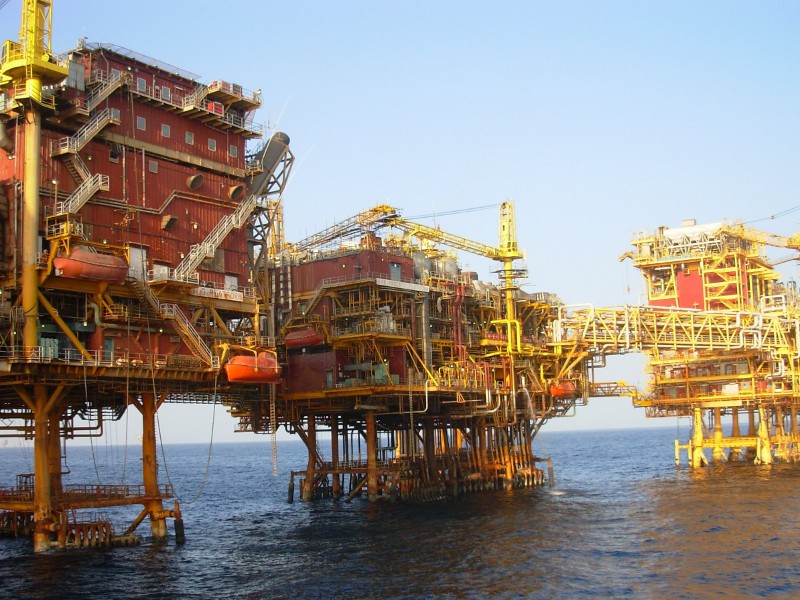Strategic Oil Reserves and Energy Security: Analysis

A major fall in the international crude oil prices prompted India to get its strategic Energy reserves filled at a low cost. Recently in a tweet, the Ministry of Petroleum and Natural Gas said that India has saved Rs. 5000 crores in foreign exchange while strengthening its energy security by filling up the strategic reserves with full capacity.
What the news is about?
- The price slump in crude oil during the Pandemic was utilized by India to fill up our strategic petroleum reserves.
- The refineries in India have also filled their commercial tanks and pipelines with refined fuel and oil.
- Apart from filling up the strategic reserves, options of storing the crude oil on ships in the high seas and renting storages in foreign countries like the USA are also being explored.
What are the strategic oil reserves?
- A Strategic Oil Reserve is a volume of crude oil placed in underground storage and excluded from the country’s proved oil reserves, mainly maintained by countries that depend on imports to meet their demand for unforeseen emergencies.
- These are emergency reserves kept filled to be used in the times of supply shocks. The emergency may be a condition of war, volatile geopolitical conditions (Gulf war of the 1990s), tensions over the high seas, a slump in production, excessive price rise due to supply chain disruption, etc.
- The strategic oil reserves are different form a nation’s proven oil reserves as the proven oil reserves are available for production.
- Many major economies like the USA, Japan, China have their own strategic petroleum reserves and keep their reserves filled over and above IEA recommended capacities.
- India, being the fastest-growing major economy for the better part of the last two decades, embarked on the mission to hold strategic reserves too.
- India’s Integrated Energy Policy of 2006 recommends a reserve, equivalent to 90 days of oil imports for strategic cum-buffer stock purposes.
- According to the agreement among the members of the International Energy Agency (IEA), any country that does not export more reserves than it imports, should maintain reserves equivalent to each country’s average 90-day crude oil imports for the previous year.
What is Energy Security?
- Energy security can be defined as the uninterrupted availability of energy sources at affordable prices.
- India is a fast-growing economy with tremendous energy needs. To achieve the needed growth and development needed to create an environment of development for its population, India has to maintain an appropriate supply of energy sources.
- The physical threats to energy security are accentuated with the increasing gap between the demand for energy sources and its domestic availability.
- The increasing import dependence is unsustainable in the long term as it drastically increases our import bill.
- The environmental targets also pose a question on the current energy mix of the country which is heavily dependent on fossil fuel-based energy sources.
Why is it important for India to have a strategic oil reserve?
- India is heavily dependent on oil imports as it owns very little oil reserves. It imports excess of 80% of its total need for oil.
- 2017 edition of BP Statistical Review of World Energy has projected India’s oil consumption growth to be the fastest among all major economies by 2035.
- Being among the large emerging economies, India is most vulnerable to oil security issues.
- The major source of crude oil, West Asia is often caught in some geopolitical tussle making imports for that region ever vulnerable.
- The geopolitics of Oil is something that remains unpredictable. During the 1971 war with Pakistan, two major companies refused to sell oil to India solely for geopolitical reasons.
- The current situation is that because of market competition between Saudi Arabia and Russia, there is a crash of prices situation but the situation could be altered in no time and there could be a huge spike in the prices.
- There is always a risk of supply disruption due to manmade or natural disasters. Latest of them being the Corona pandemic which limited the cargo movement across the globe.
- India cannot remain hostage to foreign political calculations even in case of energy security as it is hungry for growth and development now more than ever and that will only increase with time.
- Not only to strategic reserves, but India also needs an aggressive buying policy in times of oil prices crash like this one. That would be a smart proactive energy policy befitting an emerging power.
What has India done in the oil security demands?
- In January 2004, India officially decided to establish a strategic petroleum reserve.
- The Indian Strategic Petroleum Reserves Limited (ISPRL) was formed in June 2004 as a wholly-owned subsidiary of the Oil Industry Development Board (OIDB) (under the Ministry of Petroleum and Natural Gas) to implement and manage proposed reserve projects. The entire SPR volumes are expected to be in the form of crude oil.
- In 2008, the GoI approved the construction of rock caverns as Phase I of India’s strategic petroleum reserve scheme, with a total capacity of up to of 5.33 Mt (around 40 mb) in three locations – Vishakhapatnam (1.3 Mt), Mangalore (1.5 Mt), and Padur (2.5 Mt).
- As of 2019, the reserves foreseen under Phase I are estimated to supply approximately 9.2 days of India’s crude requirement, according to the consumption pattern of 2018/19.
- In October 2018, The government approved (in principle) the phase II of the Strategic petroleum reserve at Chandikhol in Odisha and at Padur in Karnataka. If completed, it will add another 11.2 days of net imports (based on 2018-19 imports).
- Indian refineries also maintain crude oil storage (Industrial storage) of 65 days.
- For the purpose of the joint stockpiling project, India is co-operating with UAE’s Abu Dhabi National Oil Company (ADNOC).
- According to the agreement, the entire amount of oil stored by ADNOC would be made available to India in case of an emergency; but in normal times, ADNOC can trade a part of the crude oil with Indian refineries on a commercial basis, while a mutually agreed minimum crude storage for emergency purposes should be kept.
What are other ways to energy security?
- India, apart from depending upon imports from oil-rich countries, is looking to diversify its energy basket.
- The Intended Nationally Determined Commitments of India pledge reduce its fossil fuel-based energy demands.
- The Indian government also gives many fiscal incentives to attract investment in the recovery of oil-fields.
- India is moving further with the plan of becoming a Gas-based economy to manage its environmental targets along with energy security. The project of City Gas Distribution and Natural Gas Grid are underway.
- Oil Ministry also plans to set up Bio-CNG plants and allied infrastructure to promote clean energy.
- National Solar Mission strives to improve solar energy capacity in India
- The sourcing of crude and LNG has been further diversified as the first Russian cargo of 2 million barrels of Urals grade oil under IOCL and Rosneft’s contract was received by IOCL at Paradip on April 8, 2020.
- Recently, India has also signed a Memorandum of Understanding with Saudi Aramco for filling the cavern in Padur.
What are the challenges to our energy security?
- The prime issue is of investment in the energy sector and hydrocarbon exploration in India, multiple policy measures failed to attract enough investment in domestic exploration.
- To build huge strategic reserves also, we need investment, and looking at the current market scenario, it is hard to attract needed investment.
- Even if built, they will not be in a position to recover the costs in near terms because of potential low demand in the near future.
- Major investments will have to be made in acquiring hydrocarbon assets abroad. Indian owned assets will have to be developed. In this sector, ONGC-Videsh is doing its bit but it lacks the necessary clout to bid aggressively on the international stage.
- Many projects like that of Kudankulam Nuclear power plant, the Ratnagiri refinery project get entangled in Socio-political controversies which makes investment challenges.
- There has been a focus on renewables in recent times but the pace is not enough. India lacks skilled manpower and Research and Development in this area.
- The solar projects have been caught in trade issues in the WTO.
- The energy security in times of crisis also mainly depends on energy diplomacy. India has to tightly balance its relations with the West and countries like Iran from which we import a heavy amount of our energy needs.
What are the possible Post-COVID energy scenario?
- The pandemic-hit Indian economy now must focus on bringing the growth trajectory back in the range of 6-7% rate.
- This necessitates going back to conventional energy sources such as oil, coal, etc and keep the renewables on a second priority for a while.
- So, oil-dependency will be there for a long time now. So, in this scenario, the strategic reserves become important.
- The Atmanirbhar Bharat can include energy resources in itself to give shot in the arm to renewables but that is a long-term plan.
- Right now, in the wake of global uncertainties and our demands, securing energy needs is most important. In this scenario, the decision to fill our reserves and look for other avenues of stockpiling is a smart move.
Way Forward
- Looking at the future, energy security will be on the priority list of Indian policymakers. Improving our strategic reserves to reach the levels of IEA standards of a 90-day reserve is the need of the hour.
- In the current situation, we cannot solely embark upon renewable energy journey. The right mix of the conventional-non-conventional energy basket is advisable.
- While securing our current needs, the non-conventional fuel sources should also be explored and capacities to utilize them must be developed.
- The thrust on CNG, bio-fuels, ethanol is a welcome improvement in our energy policy. Once we are back on track economically, we can further increase our effort in renewables.
- We also need more nuclear energy sources. The ongoing efforts in developing more nuclear energy production must be compounded with political will and social awareness so as to accelerate the projects.
- The schemes like PM Ujjwala Yojana which give thrust on LPG as the main energy source in rural household. This will create a behavioral change also so as to make the diversification of energy basket successful.
Conclusion
Renewables are no doubt the future, but oil remains the center of our economy over at least for the next decades. So we have to secure our energy needs by looking for assets abroad and exploring new avenues like storage of reserves abroad and over the high seas on ships. The current pandemic might to a blessing in disguise to reorient our energy security.
Practice Question for Mains
What are strategic oil reserves? Explain their importance in the energy security of India (200 words)
If you like this post, please share your feedback in the comments section below so that we will upload more posts like this.



